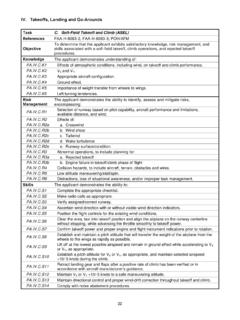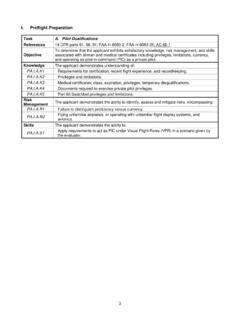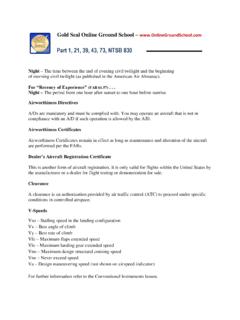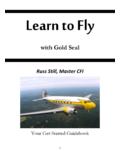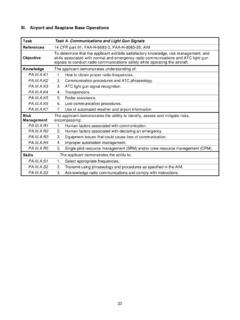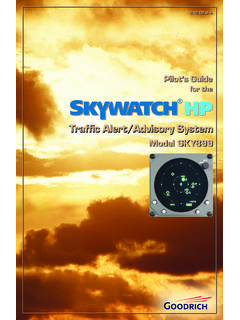Transcription of Task A. Maneuvering During Slow Flight References
1 40 VII. slow Flight and Stalls Task A. Maneuvering During slow Flight References FAA-H-8083-2, FAA-H-8083-3; POH/AFM Object ive To determine that the applicant exhibits satisfactory knowledge, risk management, and skills associated with Maneuvering During slow Flight . Note: See Appendix 6: Safety of Flight and Appendix 7: aircraft , Equipment, and Operational Requirements & Limitations. Knowledge The applicant demonstrates understanding of: Aerodynamics associated with slow Flight in various aircraft configurations, to include the relationship between angle of attack, airspeed, load factor, power setting, aircraft weight and center of gravity, aircraft attitude, and yaw effects.
2 Risk Management The applicant demonstrates the ability to identify, assess and mitigate risks, encompassing: Inadvertent slow Flight and Flight with a stall warning, which could lead to loss of control. Range and limitations of stall warning indicators ( , aircraft buffet, stall horn, etc.). Failure to maintain coordinated Flight . Effect of environmental elements on aircraft performance. ( , turbulence, microbursts, and high density altitude). Collision hazards, to include aircraft , terrain, obstacles, and wires. Distractions, loss of situational awareness, and/or improper task management.
3 Skills The applicant demonstrates the ability to: Clear the area. Select an entry altitude that will allow the Task to be completed no lower than 1,500 feet AGL (ASEL, ASES) or 3,000 feet AGL (AMEL, AMES). Establish and maintain an airspeed at which any further increase in angle of attack, increase in load factor, or reduction in power, would result in a stall warning ( , aircraft buffet, stall horn, etc.). Accomplish coordinated straight-and-level Flight , turns, climbs, and descents with landing gear and flap configurations specified by the evaluator without a stall warning ( , aircraft buffet, stall horn, etc.)
4 Maintain the specified altitude, 100 feet; specified heading, 10 ; airspeed +10/-0 knots; and specified angle of bank, 10 . From the AIM:Most skeletal structures are supported by guy wires which are very difficult to see in good weather and can be invisible at dusk or During periods of reduced visibility. These wirescan extend about 1,500 feet horizontally from a structure; therefore, all skeletal structures should be avoided horizontally by at least 2,000 slow Flight and Stalls 41 Task B. Power-Off Stalls References FAA-H-8083-2, FAA-H-8083-3; AC 61-67; POH/AFM Object ive To determine that the applicant exhibits satisfactory knowledge, risk management, and skills associated with power-off stalls.
5 Note: See Appendix 7: aircraft , Equipment, and Operational Requirements & Limitations. Knowledge The applicant demonstrates understanding of: Aerodynamics associated with stalls in various aircraft configurations, to include the relationship between angle of attack, airspeed, load factor, power setting, aircraft weight and center of gravity, aircraft attitude, and yaw effects. Stall characteristics ( , airplane design) and impending stall and full stall indications ( , how to recognize by sight, sound, or feel). Factors and situations that can lead to a power-off stall and actions that can be taken to prevent it.
6 Fundamentals of stall recovery. Risk Management The applicant demonstrates the ability to identify, assess and mitigate risks, encompassing: Factors and situations that could lead to inadvertent power-off stall, spin, and loss of control. Range and limitations of stall warning indicators ( , aircraft buffet, stall horn, etc.). Failure to recognize and recover at the stall warning During normal operations. Improper stall recovery procedure. Secondary stalls, accelerated stalls, and cross-control stalls. Effect of environmental elements on aircraft performance related to power-off stalls ( , turbulence, microbursts, and high density altitude).
7 Collision hazards, to include aircraft , terrain, obstacles, and wires. Distractions, loss of situational awareness, and/or improper task management. Skills The applicant demonstrates the ability to: Clear the area. Select an entry altitude that will allow the Task to be completed no lower than 1,500 feet AGL (ASEL, ASES) or 3,000 feet AGL (AMEL, AMES). Configure the airplane in the approach or landing configuration, as specified by the evaluator, and maintain coordinated Flight throughout the maneuver. Establish a stabilized descent. Transition smoothly from the approach or landing attitude to a pitch attitude that will induce a stall.
8 Maintain a specified heading, 10 if in straight Flight ; maintain a specified angle of bank not to exceed 20 , 10 , if in turning Flight , while inducing the stall. Acknowledge cues of the impending stall and then recover promptly after a full stall has occurred. Execute a stall recovery in accordance with procedures set forth in the POH/AFM. Retract the flaps to the recommended setting; retract the landing gear, if retractable, after a positive rate of climb is established. Accelerate to VX or VY speed before the final flap retraction; return to the altitude, heading, and airspeed specified by the evaluator.
9 VII. slow Flight and Stalls 42 Task C. Power-On Stalls References FAA-H-8083-2, FAA-H-8083-3; AC 61-67; POH/AFM Object ive To determine that the applicant exhibits satisfactory knowledge, risk management, and skills associated with power-on stalls. Note: See Appendix 6: Safety of Flight and Appendix 7: aircraft , Equipment, and Operational Requirements & Limitations. Knowledge The applicant demonstrates understanding of: Aerodynamics associated with stalls in various aircraft configurations, to include the relationship between angle of attack, airspeed, load factor, power setting, aircraft weight and center of gravity, aircraft attitude, and yaw effects.
10 Stall characteristics ( , airplane design) and impending stall and full stall indications ( , how to recognize by sight, sound, or feel). Factors and situations that can lead to a power-on stall and actions that can be taken to prevent it. Fundamentals of stall recovery. Risk Management The applicant demonstrates the ability to identify, assess and mitigate risks, encompassing: Factors and situations that could lead to inadvertent power-on stall, spin, and loss of control. Range and limitations of stall warning indicators ( , aircraft buffet, stall horn, etc.)



